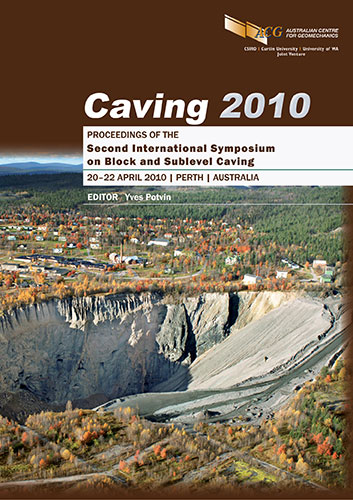Measurement of hydraulic fracture growth in a naturally fractured orebody for application to preconditioning

|
Authors: Jeffrey, RG; van As, A; Zhang, X; Bunger, AP; Chen, ZR |
DOI https://doi.org/10.36487/ACG_rep/1002_45_Jeffrey
Cite As:
Jeffrey, RG, van As, A, Zhang, X, Bunger, AP & Chen, ZR 2010, 'Measurement of hydraulic fracture growth in a naturally fractured orebody for application to preconditioning', in Y Potvin (ed.), Caving 2010: Proceedings of the Second International Symposium on Block and Sublevel Caving, Australian Centre for Geomechanics, Perth, pp. 647-662, https://doi.org/10.36487/ACG_rep/1002_45_Jeffrey
Abstract:
Hydraulic fracturing is applied for the preconditioning of orebodies prior to cave mining. A major project at Northparkes Mines was carried out in 2006 to investigate hydraulic fracture interaction with shear zones in the E48 orebody. The fracture growth was remotely monitored by tiltmeter and microseismic arrays. The mined fractures were then physically mapped and their geometry was compared to that inferred from the remote monitoring. The fractures were found to be subhorizontal, which was consistent with the tiltmeter and in situ stress data. Shear zones, natural fractures, and veins were crossed by the hydraulic fractures, sometimes producing an offset or step in the fracture path at the crossing site. One hydraulic fracture terminated at a shear zone in close proximity to a lithological contact that may be a stress change boundary. Numerical modelling of hydraulic fracture growth with offsets reveals that such fractures require a higher pressure to propagate and grow more slowly than a straight fracture. Results from numerical modelling indicated that the E48 caveability would prove problematic. The E48 orebody was, therefore, preconditioned using hydraulic fracturing and the footprint of the cave was enlarged.
References:
Brown, E.T. (2003) Block Caving Geomechanics, JKMRC Monograph Series in Mining and Mineral Processing 3, Julius Kruttschnitt Mineral Research Centre, The University of Queensland, Brisbane, 515 p.
Chacon, E., Barrera, V., Jeffrey, R.G. and van As, A. (2004) Hydraulic fracturing used to precondition ore and reduce fragment size for block caving, in Proceedings MassMin 2004 Symposium, Santiago.
Detournay, E. and Cheng, A.H-D. (1993) Fundamentals of Poroelasticity, Chapter 5 in Comprehensive Rock Engineering: Principles, Practice, and Projects, Vol. II, Analysis and Design Methods, C. Fairhurst (ed), Pergamon Press, pp. 113–171.
Jaeger, J.C. and Cook, N.G.W. (1976) Fundamentals of Rock Mechanics, John Wiley and Sons, New York, 585 p.
Jeffrey, R.G., Zhang, X. and Thiercelin, M. (2009a) Hydraulic Fracture Offsetting in Naturally Fractured Reservoirs: Quantifying a Long-Recognised Process, Paper SPE 119351 presented at the SPE Hydraulic Fracturing Technology Conference, The Woodlands, Texas, 19–21 January.
Jeffrey, R.G., Bunger, A.P., Lecampion, B., Zhang, X., Chen, Z.R., van As, A., Allison, D.P., de Beer, W., Dudley, J.W., Siebrits, E., Thiercelin, M. and Mainguy, M. (2009b) Measuring Hydraulic Fracture Growth in Naturally Fractured Rock, Paper SPE 124919 presented at the SPE Annual Technical Conference and Exhibition, New Orleans, Louisiana, 4–7 October.
Laubscher, D.H. (1990) A geomechanics classification system for the rating of rock mass in mine design, Journal of South African Institute of Mining Metallurgy, Vol. 90(10), pp. 257–273.
Lecampion, B., Jeffrey, R. and Detournay, E. (2005) Resolving the geometry of hydraulic fractures from tilt measurements, Pure Applied Geophysics, Vol. 162, pp. 2433–2452.
Lhomme, T., Detournay, E. and Jeffrey, R.G. (2005) Effect of fluid compressibility and borehole on the initiation and propagation of a transverse hydraulic fracture, Strength, fracture and complexity, Vol. 3, No. 2–4.
Mills, K.W. (1997) In situ stress measurement using the ANZI stress cell, in Proceedings International Symposium on Rock Stress, pp. 149–152.
Mills, K.W. (2007) In Situ Stress Measurements – E48 Extraction Level, unpublished Report NPK3229, SCT Operations Pty Ltd.
Mills, K.W. and Jeffrey, R.G. (2004) Remote High Resolution Stress Change Monitoring near Hydraulic Fractures, in Proceeding MassMin 2004 Symposium, Santiago.
Ray, A.K., Singh, G.S.P. and Banerjee, G. (2006) Influence of petrographic constituents on the softening characteristics of Coal Measures rock, Technical Note, International Journal of Rock Mechanics and Mining Sciences, Vol. 43, pp. 494–502.
Sainsbury, B., Pierce, M.E. and Mas Ivars, D. (2008), Analysis of Cave Behaviour using a Synthetic Rock Mass (SRM) – Ubiquitous Joint Rock Mass (UJRM) Modelling Technique, in Proceedings First Southern Hemisphere International Rock Mechanics Symposium, SHIRMS, Perth, August 2008, Vol. 1, pp. 243–253.
Soliman, M.Y., East, L. and Adams, D. (2008) Geomechanics Aspects of Multiple Fracturing of Horizontal and Vertical Wells, SPE Drilling and Completion, September 2008, pp. 217–228.
Trueman, R. and Mawdesley, C. (2003) Predicting cave initiation and propagation, CIM Bulletin, Vol. 96(1071),
pp. 54–59.
van As, A. (2004) Rock Strength Testing, unpublished Northparkes Mines report.
van As, A. and Jeffrey, R.G. (2000) Hydraulic fracturing as a cave inducement technique at Northparkes, in Proceedings MassMin 2000 Conference, pp. 165–172.
van As, A. and Jeffrey, R.G. (2002) Hydraulic fracture growth in naturally fractured rock: mine through mapping and analysis, in Proceedings North American Rock Mechanics Symposium – Tunnelling Association of Canada, Toronto, pp. 1461–1469.
van As, A., Jeffrey, R.G., Chacon, E. and Barerra, V. (2004) Preconditioning by hydraulic fracturing for block caving in a moderately stressed naturally fractured orebody, in Proceedings MassMin 2004 Symposium, Santiago.
Varley, F. and Whyatt, J. (2008) Work practices to manage bump prone ground, in Proceedings 27th International Conference on Ground Control in Mining, S.S. Peng, C. Mark, G.L. Finfinger, S.C. Tadolini, A.W. Khair, K.A. Heasley and Y. Luo (eds), Morgantown, West Virginia University, pp. 29–36.
Zhang, X., Jeffrey, R.G. and Detournay, E. (2005) Propagation of a fluid-driven fracture parallel to the free surface of an elastic half plane, International Journal for Numerical and Analytical Methods in Geomechanics, Vol. 29,
pp. 1317–1340.
Zhang, X. and Jeffrey, R.G. (2008) Reinitiation or termination of fluid-driven fractures at frictional bedding interfaces, Journal of Geophysical Research, 113 B08416, .
© Copyright 2025, Australian Centre for Geomechanics (ACG), The University of Western Australia. All rights reserved.
View copyright/legal information
Please direct any queries or error reports to repository-acg@uwa.edu.au
View copyright/legal information
Please direct any queries or error reports to repository-acg@uwa.edu.au